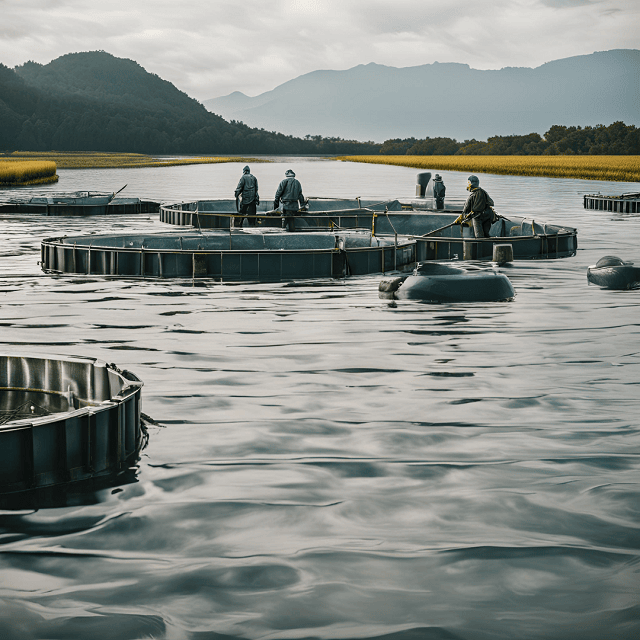
The Resilience of Fish, the ability of fish to cope with challenges and maintain their well-being, is a fundamental aspect of sustainable aquaculture.
Improving fish resilience requires a multifaceted approach that considers both the biological characteristics of the fish and the environmental conditions in which they are raised. However, the concept of resilience also raises important ethical questions that aquaculture professionals must address.
A study published by researchers from Utrecht University and Wageningen University and Research explores the ethical dimensions of resilience in aquaculture, examining the normative assumptions underlying its pursuit, the trade-offs involved, the need for a broader ethical framework, and the moral implications of manipulating fish to achieve resilience.
Understanding Resilience
- 1 Understanding Resilience
- 2 The Normative Assumptions of Resilience
- 3 Trade-offs and Ethical Dilemmas
- 4 Beyond Animal Welfare: A Broader Ethical Framework
- 5 Moral Implications of Manipulating Fish to Achieve Resilience
- 6 Ethical Considerations for Aquaculture Professionals
- 7 Conclusion
- 8 Entradas relacionadas:
The study published in the journal Fish Biology highlights that “fish resilience can be understood as the ability of fish to successfully respond to a challenge so that they can function and thrive as they did before the challenge occurred.” While it is often seen as a desirable trait, it is essential to distinguish resilience from adaptation and robustness.
Adaptation involves permanent behavioral changes, while robustness relates to the ability to maintain productivity in various environments.
The Normative Assumptions of Resilience
The concept of resilience often carries a positive connotation, implying that resilient fish are better adapted to their environment and experience greater well-being. However, this view is inherently normative, assuming a “win-win” scenario where resilience benefits both the fish and the producers.
This assumption overlooks the potential trade-offs between the individual well-being of the fish and system-level objectives, as well as the ethical implications of prioritizing resilience over other considerations.
Trade-offs and Ethical Dilemmas
Improving resilience often involves making trade-offs between different priorities. For example, enhancing the robustness of individual fish may require sacrificing aspects of their natural behavior or social interactions. Similarly, adapting the production environment to meet the specific needs of fish may involve compromising other goals, such as maximizing production efficiency or minimizing environmental impact.
Stay Always Informed
Join our communities to instantly receive the most important news, reports, and analysis from the aquaculture industry.
These trade-offs raise ethical questions about the relative importance of different factors when assessing fish welfare and the extent to which we can justify prioritizing resilience over other considerations.
Beyond Animal Welfare: A Broader Ethical Framework
The debate on resilience in aquaculture highlights the need to move beyond a traditional animal welfare framework. A broader ethical perspective should consider the agency of fish and their capacity to experience positive emotions and meaningful lives.
This approach requires asking not only how we can improve fish welfare but also what the fish themselves want and how we can empower them to have more control over their circumstances. This may also influence our definition of resilience and how we implement it.
Moral Implications of Manipulating Fish to Achieve Resilience
The pursuit of resilience raises moral concerns about the extent to which we should manipulate fish for our own purposes. While enhancing resilience may be seen as a way to improve the quality of life for fish, it also raises questions about the limits of human intervention.
Physically adapting fish to withstand harsh circumstances can be viewed as instrumentalizing them, reducing them to mere objects for our benefit.
Ethical Considerations for Aquaculture Professionals
To ensure that resilience is pursued ethically and responsibly, aquaculture professionals should:
- Recognize the normative assumptions underlying the concept of resilience.
- Consider the potential trade-offs between fish welfare and production efficiency.
- Adopt an agency-centered approach to animal ethics.
- Reflect on the moral implications of interventions aimed at enhancing resilience.
- Engage in open dialogue with stakeholders to address ethical concerns.
Conclusion
Resilience is a complex concept with both biological and ethical dimensions. By carefully considering the ethical implications of strategies to improve resilience, aquaculture professionals can contribute to the development of sustainable and responsible fish farming practices that prioritize the welfare of both fish and the environment.
To ensure that resilience initiatives are implemented responsibly, it is essential to:
- Explicitly address ethical dimensions: When developing resilience measures, it is crucial to openly discuss and consider the ethical implications involved.
- Consider multiple stakeholders: Resilience should not only benefit fish but also humans, ecosystems, and other relevant parties.
- Evaluate trade-offs: Achieving resilience may involve trade-offs, such as sacrificing genetic diversity or increasing costs.
- Explore alternatives: A broad perspective is necessary to identify and assess alternative approaches that may have fewer ethical downsides.
- Engage all stakeholders: Incorporating ethical considerations into the development process helps ensure that the needs and interests of all involved, including fish and ecosystems, are taken into account.
Contact
Franck L. B. Meijboom
Faculty of Veterinary Medicine, Centre for Sustainable Animal Stewardship, Department of Population Health Science, Utrecht University
Utrecht, The Netherlands.
Email: f.l.b.meijboom@uu.nl
Reference (open access)
B. Meijboom, F. L., & Bovenkerk, B. 2024. Fish resilience as an ethical issue. Journal of Fish Biology. https://doi.org/10.1111/jfb.15973
Editor at the digital magazine AquaHoy. He holds a degree in Aquaculture Biology from the National University of Santa (UNS) and a Master’s degree in Science and Innovation Management from the Polytechnic University of Valencia, with postgraduate diplomas in Business Innovation and Innovation Management. He possesses extensive experience in the aquaculture and fisheries sector, having led the Fisheries Innovation Unit of the National Program for Innovation in Fisheries and Aquaculture (PNIPA). He has served as a senior consultant in technology watch, an innovation project formulator and advisor, and a lecturer at UNS. He is a member of the Peruvian College of Biologists and was recognized by the World Aquaculture Society (WAS) in 2016 for his contribution to aquaculture.




